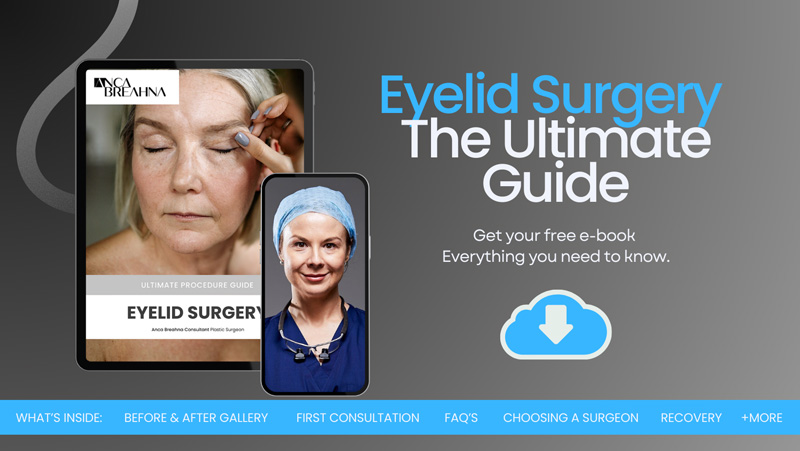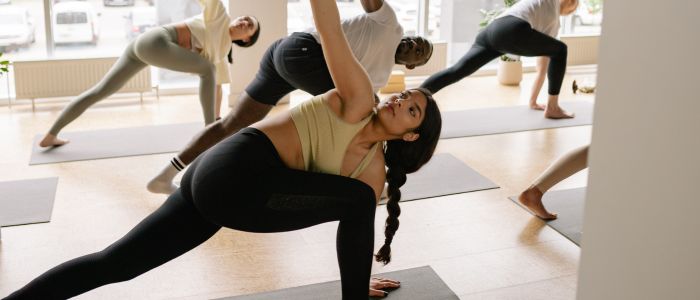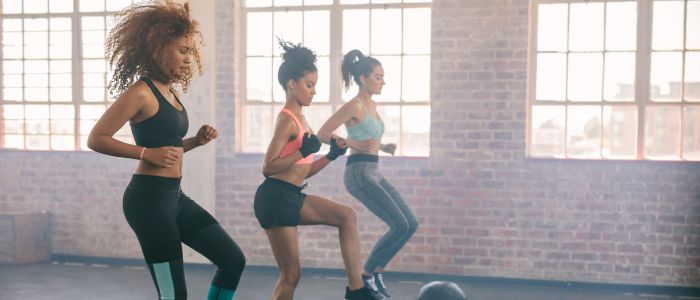
Safe Exercises for the First 2 Months Post-Op
As with any surgical procedure, proper post-operative care is essential to ensure optimal healing and results after blepharoplasty. A critical component of this care involves knowing when and how to resume exercise after blepharoplasty safely.
In this blog, Consultant Plastic Surgeon Anca Breahna provides guidelines on exercising after blepharoplasty.
Download the Eyelid Surgery Guide

What is Blepharoplasty?
Blepharoplasty is a surgical procedure designed to correct defects, deformities, or disfigurations of the eyelids. It involves removing excess skin, muscle, and sometimes fat from the upper and lower eyelids. This procedure can be performed for both functional reasons, such as improving vision obstructed by droopy eyelids, and for cosmetic purposes.
Exercise after Blepharoplasty Surgery
After blepharoplasty, it is important to balance rest with light physical activity to support recovery. Initial weeks should focus on minimal exertion to prevent complications such as increased swelling, bruising, or bleeding. Gradually reintroducing specific types of exercise can aid in overall recovery without compromising the surgical results. Following a structured plan that outlines which exercises are safe at different stages post-surgery ensures that you maintain physical health while allowing proper healing of the eyelids.
Light Exercises to Avoid Stiffness after Blepharoplasty
Engaging in light exercises post-blepharoplasty is essential for maintaining overall physical health and preventing stiffness while ensuring that the surgical site heals properly. Here is a detailed guide on the types of light exercises you can perform and when you can safely do them during your recovery.
Gentle Movements
- Short Walks: After your surgery, it’s important to stay mobile to promote circulation and prevent stiffness. Short, gentle walks around your home or yard are ideal. Aim for 5-10 minutes at a time, a few times a day. These walks should be at a slow, steady pace, avoiding any quick or jerky movements to ensure minimal strain on your body.
- Neck and Shoulder Rolls: Sit comfortably and perform slow neck rolls to the left and right. Follow this with gentle shoulder rolls. These movements help release tension and promote relaxation without putting strain on your eyes or the surgical area.
Gradual Increase in Activity
- Extended Walks: As you begin to feel more comfortable, you can gradually increase the duration of your walks. Aim for 15-20 minutes at a comfortable pace. You can walk two to three times daily, ensuring you listen to your body and stop if you feel any discomfort.
- Light Stretching: Incorporate gentle stretching exercises to maintain flexibility. Stretch your arms overhead, gently reach to the sides, and perform seated leg stretches. Avoid any stretches that require bending forward or putting your head down to prevent pressure build-up around the eyes.
- Seated Exercises: Engage in seated exercises such as seated marches (lifting your knees alternately while sitting) and gentle torso twists. These exercises help maintain flexibility and muscle tone without exerting too much effort.
Gentle Stretches
- Arm Circles: Perform gentle arm circles, starting with small rotations and gradually increasing the range of motion. This exercise improves shoulder mobility and blood circulation without exerting too much effort.
- Leg Raises: While seated or lying down, perform gentle leg raises. This helps in maintaining leg strength and flexibility. Ensure your movements are controlled and avoid any sudden or jerky motions.
Yoga and Breathing Exercises after Blepharoplasty
Here’s a detailed guide on the types of yoga and breathing exercises you can safely perform during your recovery and the appropriate timing for each.
Gentle Breathing Exercises
Diaphragmatic Breathing
Diaphragmatic breathing, also known as deep belly breathing, is an excellent way to promote relaxation and improve oxygen flow. This exercise can be started as soon as you feel comfortable post-surgery.
- How to Perform: Sit or lie down in a comfortable position. Place one hand on your chest and the other on your abdomen. Take a deep breath in through your nose, ensuring your diaphragm (not your chest) inflates with enough air to create a slight stretch in your lungs. Exhale slowly through your mouth.
- Frequency: Perform this exercise for 5-10 minutes, several times a day. It can be particularly helpful before sleeping or any time you feel stressed.
4-7-8 Breathing
The 4-7-8 breathing technique can help manage anxiety and promote a sense of calm, which is beneficial during the recovery process.
- How to Perform: Sit or lie in a comfortable position. Inhale quietly through your nose for 4 seconds. Hold your breath for a count of 7. Exhale completely through your mouth, making a whoosh sound, for 8 seconds. This counts as one breath.
- Frequency: Aim to complete four breath cycles in one session, performing this exercise two to three times daily.
Gentle Yoga Exercises
Seated Mountain Pose
The seated mountain pose is a gentle yoga pose that helps improve posture and breathing without putting pressure on the eyes.
- How to Perform: Sit comfortably with your spine straight, shoulders relaxed, and feet flat on the floor. Place your hands on your thighs with palms facing down. Close your eyes, take a deep breath in, and imagine a string pulling the crown of your head upwards, lengthening your spine.
- Frequency: Hold this pose for 5-10 breaths, repeating it several times throughout the day.
Seated Forward Bend
This pose helps stretch the back and shoulders gently.
- How to Perform: Sit on the edge of a chair with your feet flat on the floor. Slowly bend forward from your hips, reaching your hands towards your feet. Keep your head in a neutral position and avoid bending too far.
- Frequency: Hold this pose for 3-5 breaths and repeat it 2-3 times a day.
Seated Cat-Cow Stretch
This exercise gently stretches your spine and shoulders, promoting flexibility and easing tension.
- How to Perform: Sit with your feet flat on the floor and hands on your knees. Inhale, arching your back and tilting your pelvis forward while lifting your chest and looking up (Cow Pose). Exhale, rounding your spine and tilting your pelvis back, tucking your chin towards your chest (Cat Pose).
- Frequency: Perform this sequence for 5-10 breath cycles, repeating 2-3 times daily.
Standing Mountain Pose
As you progress, you can introduce gentle standing poses that do not require bending.
- How to Perform: Stand with your feet hip-width apart and arms at your sides. Ground your feet, engage your thighs, and lift your chest. Extend your arms overhead with palms facing each other. Hold your head in a neutral position, gazing forward.
- Frequency: Hold for 5-10 breaths, practicing this pose once or twice daily as your recovery progresses.
Combining breathing exercises with yoga poses can enhance their benefits. For instance, practice deep diaphragmatic breathing while holding the seated mountain pose or the 4-7-8 breathing technique during the seated cat-cow stretch. This integration promotes a deeper sense of relaxation and helps manage any post-surgery stress or discomfort.
Aerobic Workouts after Blepharoplasty
Engaging in aerobic workouts after blepharoplasty is essential for maintaining cardiovascular health and overall physical fitness. However, it’s important to approach aerobic exercise with caution to avoid compromising the healing process. Here is a detailed guide on safe aerobic exercises and when to perform them during your recovery:
Minimal Activity during Initial Recovery Phase
During the initial recovery period following blepharoplasty, your primary focus should be on rest and allowing the surgical site to heal. Strenuous aerobic activities should be avoided to prevent increased swelling, bruising, or other complications.
Gradual Increase in Aerobic Activity
As you progress in your recovery, you can gradually increase the duration and intensity of your aerobic workouts. The key is to monitor your body’s response and avoid any activities that cause discomfort or strain.
Extended Walking
- When to Start: About two weeks post-surgery, if you feel comfortable and have Anca’s approval.
- How to Perform: Increase your walking duration to 15-20 minutes, maintaining a comfortable pace. Aim to walk two to three times daily.
- Benefits: Extended walking continues to improve circulation, supports cardiovascular health, and gently reintroduces your body to regular physical activity.
Stationary Biking
- When to Start: Approximately four weeks after surgery, depending on your individual recovery progress and after consulting Anca.
- How to Perform: Use a stationary bike with minimal resistance. Begin with sessions lasting 10-15 minutes and gradually increase the duration as you feel more comfortable.
- Benefits: Stationary biking provides a low-impact aerobic workout that helps maintain cardiovascular fitness and muscle tone without excessive strain on the body.
Incorporating Light Aerobic Activities
Low-Impact Aerobics
- When to Start: Around six weeks post-surgery, if you have healed well.
- How to Perform: Engage in low-impact aerobic activities such as light dance routines, water aerobics, or gentle aerobics classes designed for beginners. These activities should be performed at a moderate intensity, avoiding any high-impact moves.
- Benefits: Low-impact aerobics help improve cardiovascular endurance, flexibility, and overall fitness while being gentle on the body.
Light Jogging
- When to Start: Approximately eight weeks after surgery, depending on your recovery.
- How to Perform: Begin with light jogging sessions, starting with short intervals of jogging interspersed with walking. Gradually increase the duration of jogging intervals as your stamina improves.
- Benefits: Light jogging boosts cardiovascular health, enhances stamina, and promotes a sense of well-being without placing excessive strain on your surgical site.
Exercises to Avoid in the First 2 Months after Blepharoplasty
During the first two months after blepharoplasty, it is important to avoid certain exercises that could jeopardise your recovery. Here are specific types of activities to steer clear of and the reasons why they should be avoided:
High-Impact Sports
High-impact sports, such as running, basketball, soccer, and tennis, involve significant physical exertion and sudden, jarring movements. These activities can increase blood pressure and heart rate, leading to increased swelling and bruising around the eyes. Additionally, the risk of accidental collisions or impacts can cause direct trauma to the surgical area, potentially resulting in complications such as bleeding or reopening of the incision sites. During the early stages of recovery, even seemingly mild high-impact activities can pose a significant risk, delaying the healing process and compromising the surgical results.
Heavy Weight Lifting
Heavy weight lifting and strenuous resistance training should be avoided during the first two months post-surgery. Lifting heavy weights can significantly increase intra-abdominal and intra-thoracic pressure, which can, in turn, elevate blood pressure and increase the risk of bleeding and swelling around the eyes. The strain associated with heavy lifting can also lead to facial muscle tension, potentially affecting the delicate tissues around the surgical site. Instead, opt for light resistance exercises with minimal weight or resistance bands, focusing on maintaining muscle tone without exerting excessive strain.
Activities Involving Head Down Positions
Activities that involve bending over or placing your head in a downward position, such as certain yoga poses (e.g., downward-facing dog), pilates exercises, and even household chores like mopping or vacuuming, should be avoided. These positions can cause increased pressure in the head and around the eyes, leading to swelling and potential complications in the surgical area. Maintaining a neutral head position is crucial to ensure that pressure does not build up, which can adversely affect the healing process.
Instead of these activities, focus on exercises that keep your head in a neutral or elevated position. For example, gentle walking, seated exercises, and light stretches that do not require bending forward can help maintain physical activity levels without risking your recovery.
FAQs about When to Exercise after Blepharoplasty
What are the risks of exercising too soon after blepharoplasty?
- Exercising too soon after blepharoplasty can lead to several complications, including increased swelling and bruising around the eyes, which can delay the healing process. Engaging in strenuous activities can also cause bleeding or reopen incision sites, leading to infections and other serious issues. High-impact exercises can result in accidental trauma to the surgical area, potentially compromising the results of the surgery.
How long should I wait before resuming my regular gym workouts?
- You should generally wait at least six to eight weeks before resuming regular gym workouts, especially those involving heavy lifting, high-impact activities, or intense cardiovascular exercises. This timeframe allows your body to heal adequately and reduces the risk of complications.
Can I practice yoga after blepharoplasty?
- Yes, you can practice yoga after blepharoplasty, but it’s important to avoid poses that involve bending forward or placing your head in a downward position for the first two months. Focus on gentle, seated, or standing poses that maintain a neutral head position. Gentle stretches and breathing exercises are beneficial and safe during the initial recovery period.
When can I start doing aerobic exercises like running or cycling?
- Low-impact aerobic exercises like stationary cycling can typically be resumed around four weeks post-surgery, provided you feel comfortable and have Anca’s approval. High-impact aerobic exercises, such as running, should be avoided for at least six to eight weeks. Always start with low-intensity activities and gradually increase the intensity as your recovery progresses.
Are there any signs that I should stop exercising and consult my surgeon?
- Yes, if you experience increased swelling, pain, bruising, bleeding, or any signs of infection (such as redness, warmth, or discharge from the surgical site) while exercising, you should stop immediately and consult your surgeon. These symptoms could indicate that the activity is too strenuous or that there is a complication in your recovery. It’s important to listen to your body and seek medical advice if you have any concerns during your post-operative period.
Further Reading about Blepharoplasty with Consultant Plastic Surgeon Anca Breahna
- Read more about Blepharoplasty for Seniors
- Read more about Blepharoplasty and Contact Lenses
- Read more about What Do Blepharoplasty Scars Look Like?
- Read more about How to Reduce Swelling and Bruising after Blepharoplasty Surgery
- Read more about Upper Blepharoplasty Recovery Day by Day
- Read more about Preventing Complications in Blepharoplasty
- Read more about Non-Surgical Alternatives to Blepharoplasty: Do They Really Work?
Medical References about Blepharoplasty
- Blepharoplasty (Eyelid Surgery) – Cleveland Clinic
- Eyelid Surgery Procedure Steps – American Society of Plastic Surgeons
- Blepharoplasty (Eyelid Surgery) – WebMD
- Blepharoplasty – Mayo Clinic
- Eyelid Surgery Recovery – American Society of Plastic Surgeons



 Ms Anca Breahna, PhD, MSc, FEBOPRAS, FRCS (Plast) is a highly regarded Consultant Plastic Surgeon specialising in the field of Aesthetic and Reconstructive Plastic Surgery. Anca performs a range of
Ms Anca Breahna, PhD, MSc, FEBOPRAS, FRCS (Plast) is a highly regarded Consultant Plastic Surgeon specialising in the field of Aesthetic and Reconstructive Plastic Surgery. Anca performs a range of 